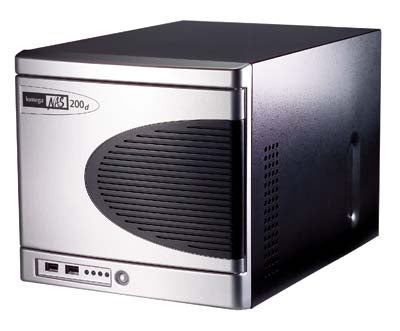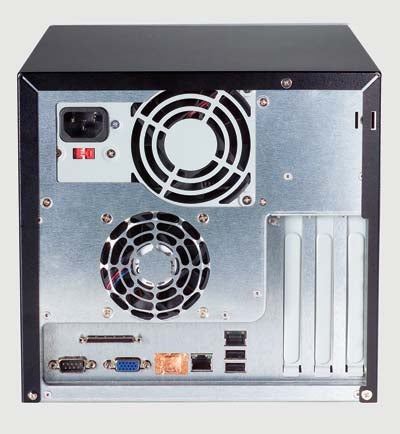Iomega NAS 200d Review
Iomega NAS 200d
Iomega is aiming at the SME market with its 200d Network Attached Storage appliance. But is it actually too heavily featured for its target market?

Verdict
Key Specifications
- Review Price: £1535.00
There are few, if any, manufacturers that have focused their entire product line so successfully on removable storage as Iomega. Over the years the ZIP drive has become synonymous with personal storage and now the REV looks poised to take its place.
However, Iomega has also traditionally had a strong presence in the network storage market and offers a solid range of NAS (Network Attached Storage) appliances. The latest model, the NAS 200d is aimed at smaller businesses with two models offering 320GB or 480GB capacities and RAID protection.
Design has always been Iomega’s forte and the 200d is no exception. It’s a solid cube that exudes quality and offers a good hardware specification based on a 2GHz Intel Celeron processor and 512MB of DDR SDRAM.
The 480GB model on review is equipped with a triplet of 160GB Hitachi Serial ATA hard drives in removable carriers. These are accessed behind the front door but are only cold-swap units so the appliance must be powered down before any can be removed and replaced. The 200d is well endowed with network connectivity with a pair of Intel Gigabit Ethernet adapters and these can be teamed together for fault tolerant or high speed links.

One feature that makes this appliance stand out is the operating system as its core. Most low-end NAS appliances rely on a simple Linux kernel but the 200d is a comparative heavyweight as it runs Microsoft’s Windows Storage Server 2003 (WSS2003). The bottom line is this enables it to offer a lot of storage related features that you don’t often see at this price point.
Two installation methods are available and either will get the appliance up and running in minutes. You can connect a monitor and USB mouse and keyboard and configure the appliance locally. Alternatively, you can leave it headless and use Iomega’s Discovery utility, which displays any appliances it encounters on the network. Pick one from the list and you can modify its IP address or move directly to a secure browser link for further remote configuration and management. The WSS2003 administrative interface is simple enough to navigate and those familiar with older Windows 2000 powered NAS appliances will be quite comfortable with this. As Windows Terminal Services is a core component of WSS2003 you can also manage it using the Remote Desktop Connection.
RAID is handled in software and the three drives are preconfigured as an 8GB RAID-1 mirror for the operating system, whilst the remainder is set up as a RAID-5 array which can be split up into multiple volumes.
Shares are simple to create and all access is controlled with local or domain users and groups and Active Directory is, of course, supported. Quotas strictly control disk usage by limiting the amount of space a user can access and sending out warnings when these thresholds are being approached. Passive quotas merely log these events but you can deny users any more space if the limits are exceeded. Directory quotas are used to limit directory or partition disk space irrespective of who is using it. Passive and active settings can be applied and a wide range of options can be stored as policies, applied to different directories and containing a range of alert types.
File screening is another useful tool as it enables you to create policies that decide what file types can be stored on the appliance. Client options may be a bit excessive for the target market but the appliance does support the CIFS/SMB, NCP, AFP and NFS file protocols so Windows, Unix, Linux, Macintosh and Netware clients can access it. The appliance can also be used as an FTP server as well.
Data backup options are plentiful as you can use the Volume Shadow Copy Service to take scheduled point-in-time snapshots of selected volumes. The appliance also incorporates an Adaptec Ultra320 SCSI controller and the single channel is routed through to the rear enabling external devices such as tape drives to be connected.

For general appliance backup you can use the Windows Backup utility or spend a bit extra and purchase the optional Symantec Backup Exec for which a trial version is ready to go. Additionally, workstation data can also be secured to the appliance with Iomega’s Automatic Backup software. This runs a local utility on each user’s PC that monitors selected disks for any file changes and automatically secures modifications in real time or at specified intervals directly to the appliance. You even get anti-virus measures as standard with the pre-installed Computer Associates eTrust AntiVirus utility, which provides real-time monitoring of all drives on the appliance and on-demand scanning. It’s also worth noting that daily virus signature updates are included in the price making the 200d look even better value.
”’Verdict”’
With WSS2003 at the helm there’s no denying the NAS 200d provides a lot of storage related features for your money. Although some small businesses will find the number of options far in excess of what they need and this is unfortunately reflected in the price. Undoubtedly though, Iomega is offering a very sleek appliance with a good hardware specification plus a wealth of data backup options and storage management tools. However, you should look carefully at whether your business will benefit from its heavy feature-set before taking the plunge.

